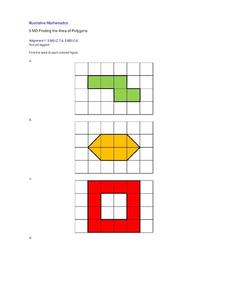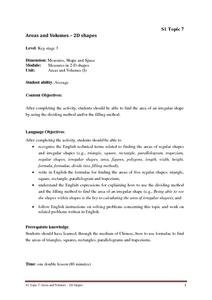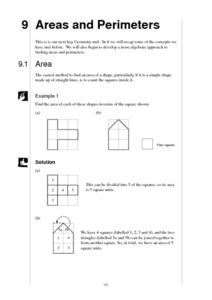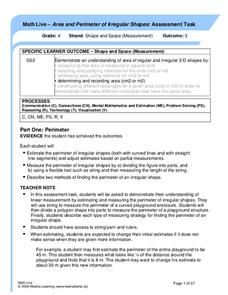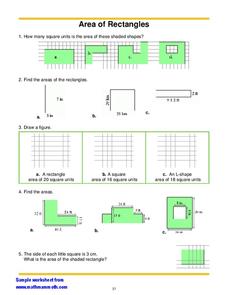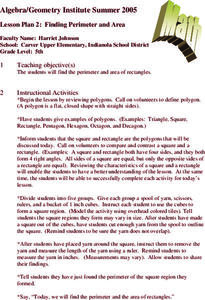Curated OER
Finding the Area of Polygons
Third graders are exposed to finding the area of polygons by decomposing figures and recomposing them into rectangles. This strategy allows children to expand on their prior knowledge of constructing shapes by rearranging parts into...
Common Core Sheets
Finding Side Length (Given Area)
Area is the amount of space that takes up the inside of a figure. To find the area of a rectangle, one must multiply the length by the width. Here, third graders are challenged to find the missing side length, given the area.
Curriculum Corner
Area and Perimeter
Get third graders excited to work find area and perimeter of unit squares, rectangles, and irregular shapes. A 36-page packet comes with task cards, graphic organizers, practice worksheets, printables with squares, exit tickets, and word...
Common Core Sheets
Determining Rectilinear Area
Third graders find the area of rectilinear shapes by partitioning them into two non-overlapping rectangles and adding the areas of the non-overlapping parts together. It allows learners to recognize area as an additive.
Common Core Sheets
Finding Area
Practice makes proficient! Here, 10 versions make up an area worksheet in which mathematicians find the area rectangles and squares in centimeters.
EngageNY
More Problems on Area and Circumference
Perimeter check! Pairs work on finding the areas of semicircles and quarter circles using a relationship with squares. The problems challenge pupils to find areas of composite figures made from rectangles, semicircles, and quarter circles.
Buffalo State
A Five Day Approach to Using Technology and Manipulatives to Explore Area and Perimeter
Young mathematicians build an understanding of area and perimeter with their own two hands in a series of interactive geometry lessons. Through the use of different math manipulatives, children investigate the properties of...
Math Mammoth
Finding the Area of Rectangles, Parallelograms, and Triangles
In this area of polygons activity, 9th graders solve two area of rectangles, one area of parallelogram, and ten area of triangles problems. The formulas for finding the area of these figures are provided.
Curated OER
Finding the Area and Perimeter of Polygons
Seventh graders practice finding the area and perimeter of polygons. In this polygon area activity, 7th graders brainstorm shapes and take a walk to locate shapes. Students record properties of shapes and use various shapes to make...
Doing Maths
Area of Various Shapes
Find the area of triangles, rectangles, and parallelograms using this metric worksheet.
Common Core Sheets
Determining Area with Square Units
Third graders measure area by counting unit squares inside a rectangle.
EngageNY
Area Problems with Circular Regions
Uncover strategies for finding areas of composite figures. The 23rd lesson in a 29-part module has young mathematicians decompose figures to find total area. Figures decompose to rectangles and circular regions.
Government of Hong Kong
Areas and Volumes - 2D Shapes
Unfortunately for young mathematicians, the world isn't made entirely of parallelograms, triangles, and trapezoids. After first learning the area formulas for these common shapes, students apply this new knowledge to...
Centre for Innovation in Mamatics Teaching
Areas and Perimeters
Cover some serious area in your geometry curriculum with this collection of worksheets. After first introducing the concept of area using the tiling method, this resource continues on to teach learners how to use...
Alberta Learning
Area and Perimeter of Irregular Shapes
Evaluate young mathematicians' understanding of area and perimeter with this series of three assessment tasks. Challenging students to not only calculate the area and perimeter of irregular shapes, but to explain in writing their...
PBS
Garden Grade 6 Area and Perimeter
Engage young mathematicians in applying their knowledge of area and perimeter with a fun geometry lesson. Through a series of problem solving exercises, children use their math knowledge to design different-sized garden...
Curated OER
Does Your Rectangle Have Guts?
Does it? Kids find the perimeter and area of different shapes to assess whether their rectangle has guts. In addition to finding the area of a rectangle, learners work to find the area of a trapezoid. All worksheets are included.
Common Core Sheets
Finding Area by Tiling
Third graders find area by tiling a rectangle based on the given side lengths. This helps learners visualize and create the area of a figure. From here, they can count the total number of tiles inside the rectangle to find the answer.
Common Core Sheets
Creating Area and Perimeter Rectangles
Third graders are challenged to draw their own rectangles given a specific area or perimeter. There are no examples of how each rectangle should look, so it is important for learners to persevere in finding a solution. There is more...
EngageNY
The Area of a Circle
Introduce learners to two methods to estimate the formula for the area of a circle. The first method uses a sector of a circle to form a rectangle, and the other uses grids to estimate the area. The problems in the 18th segment of a...
Math Mammoth
Area of Rectangles
In this geometry worksheet, 4th graders identify how many square units is the area of each of the shaded shapes. Then they find the areas of the rectangles when the sides are given. Students also draw the figure described for each.
Curated OER
Area of Rectangles and Triangles
Eighth graders practice calculating the perimeter of different shapes. As a class, they work together to calculate the area of rectangles and triangles using the proper formula. To end the activity, they determine how many feet are in...
Curated OER
Finding Perimeter and Area
Geometers find the perimeter and area of rectangles. They discuss the definitions and characteristics of rectangles and squares. In groups, they use yarn to discover the perimeter of squares and rectangles. They count cubes to explore...
Curated OER
Investigation Area of Geometric Shapes
Fourth graders use triangle paper to design patterns using geometric figures and find the areas of those figures by counting units. Students are assessed by determining which figure has the greatest area and explaining their reasoning.
